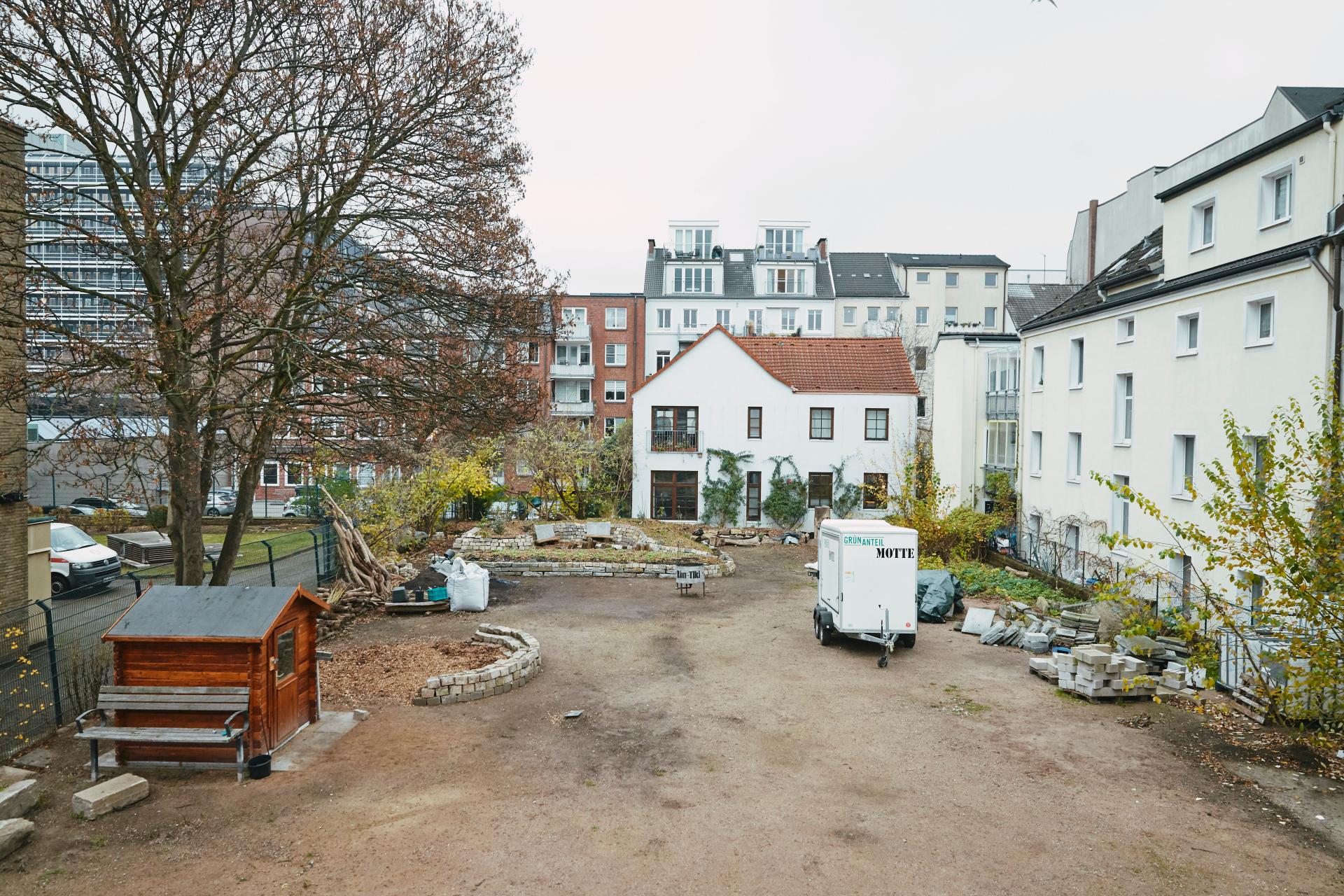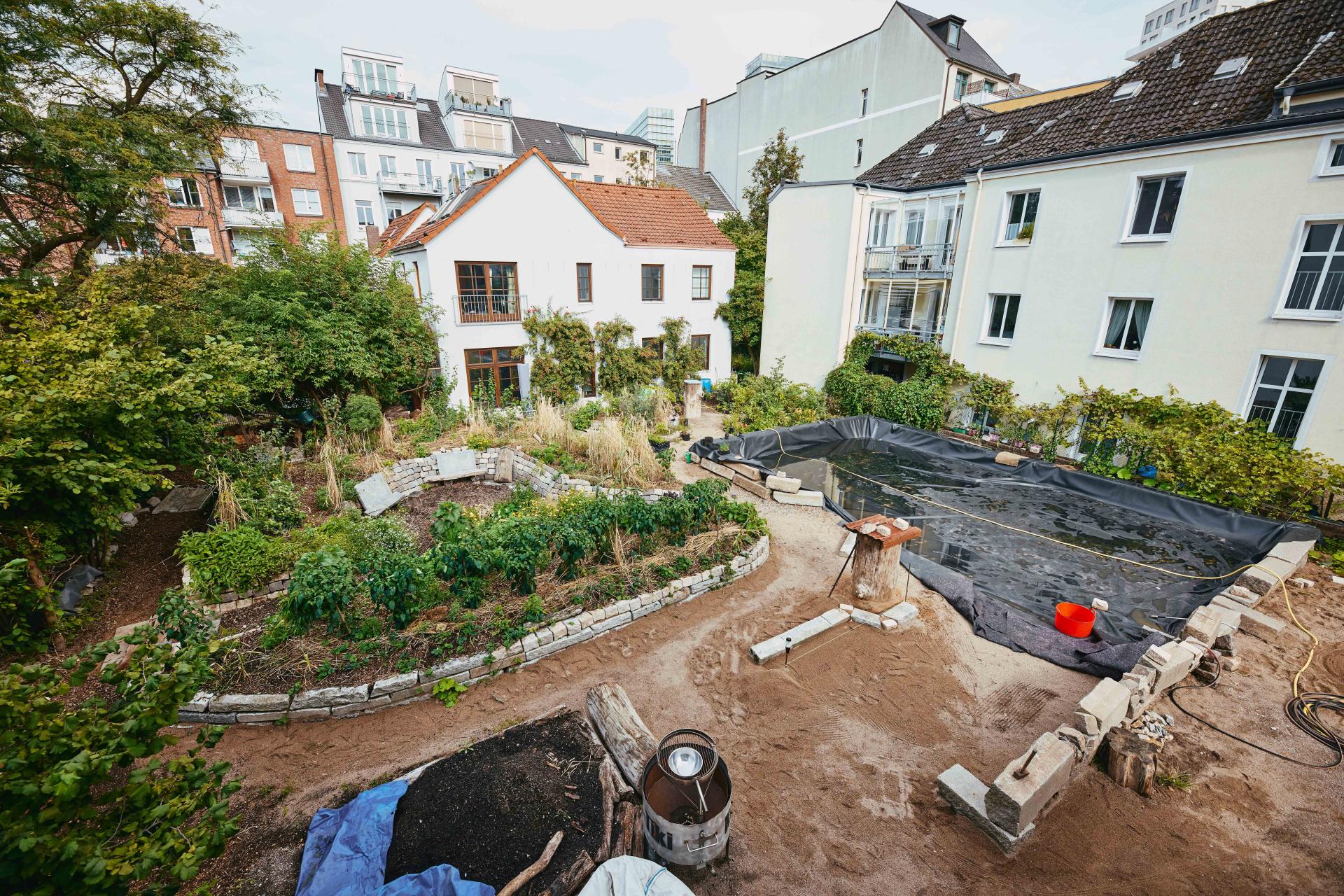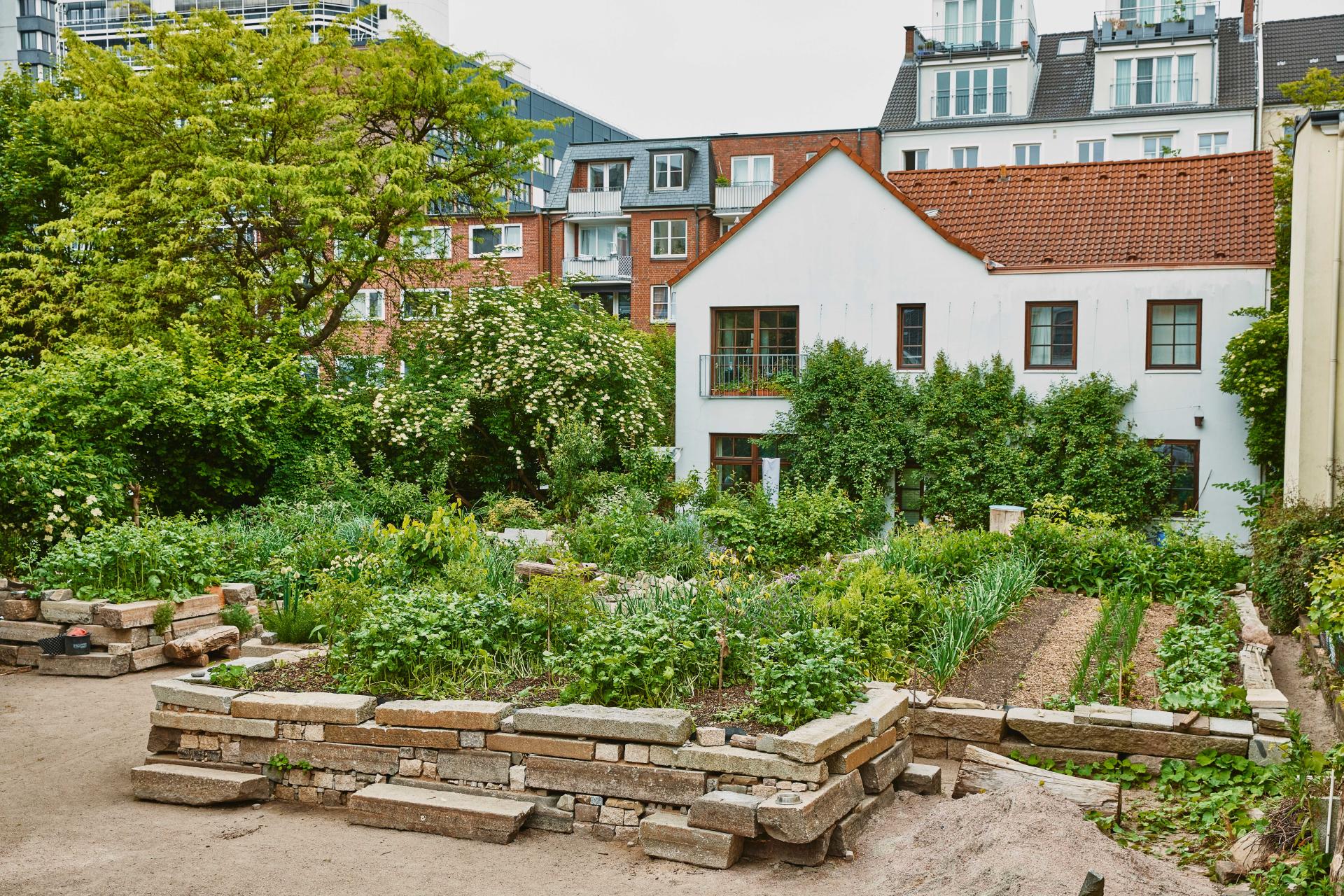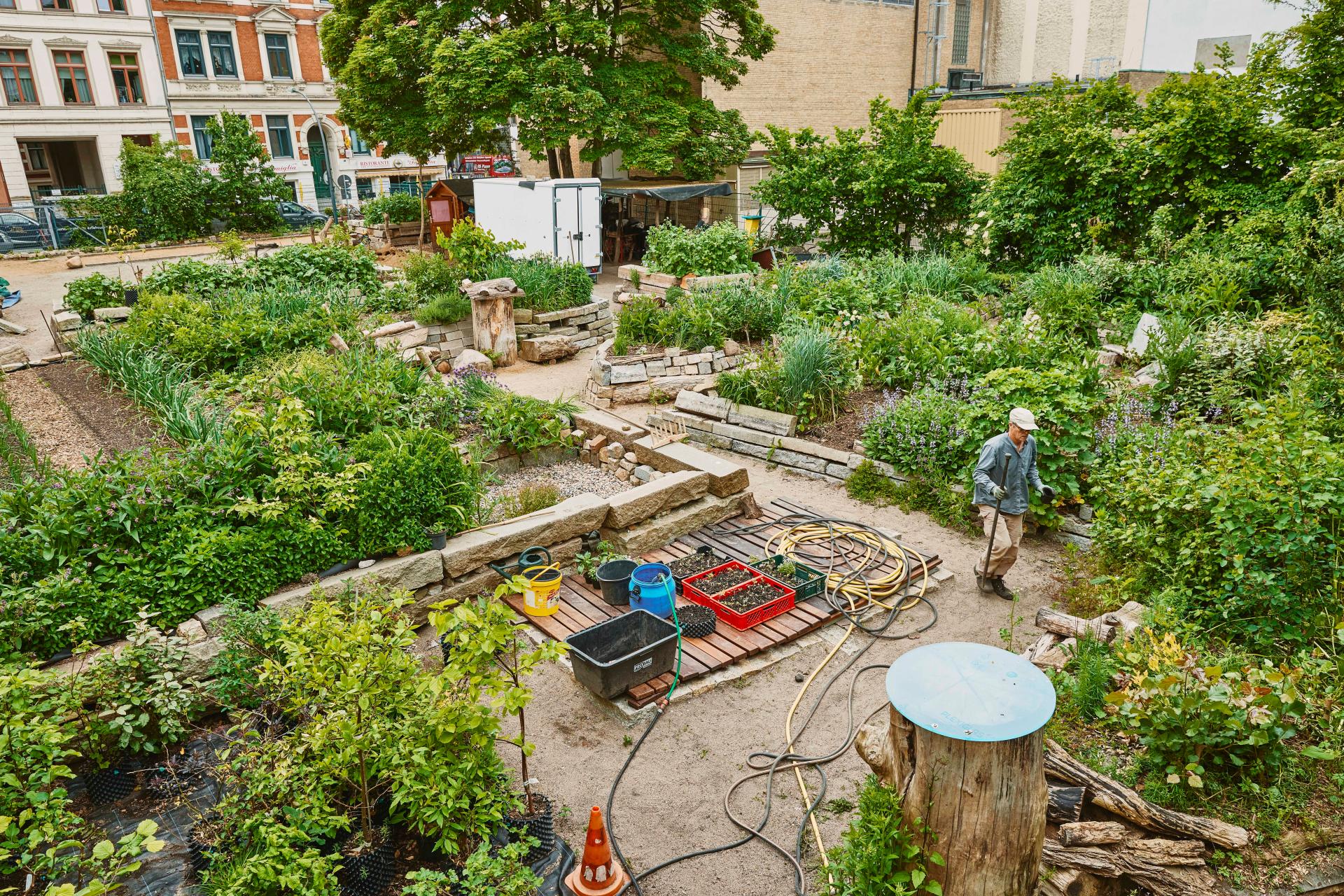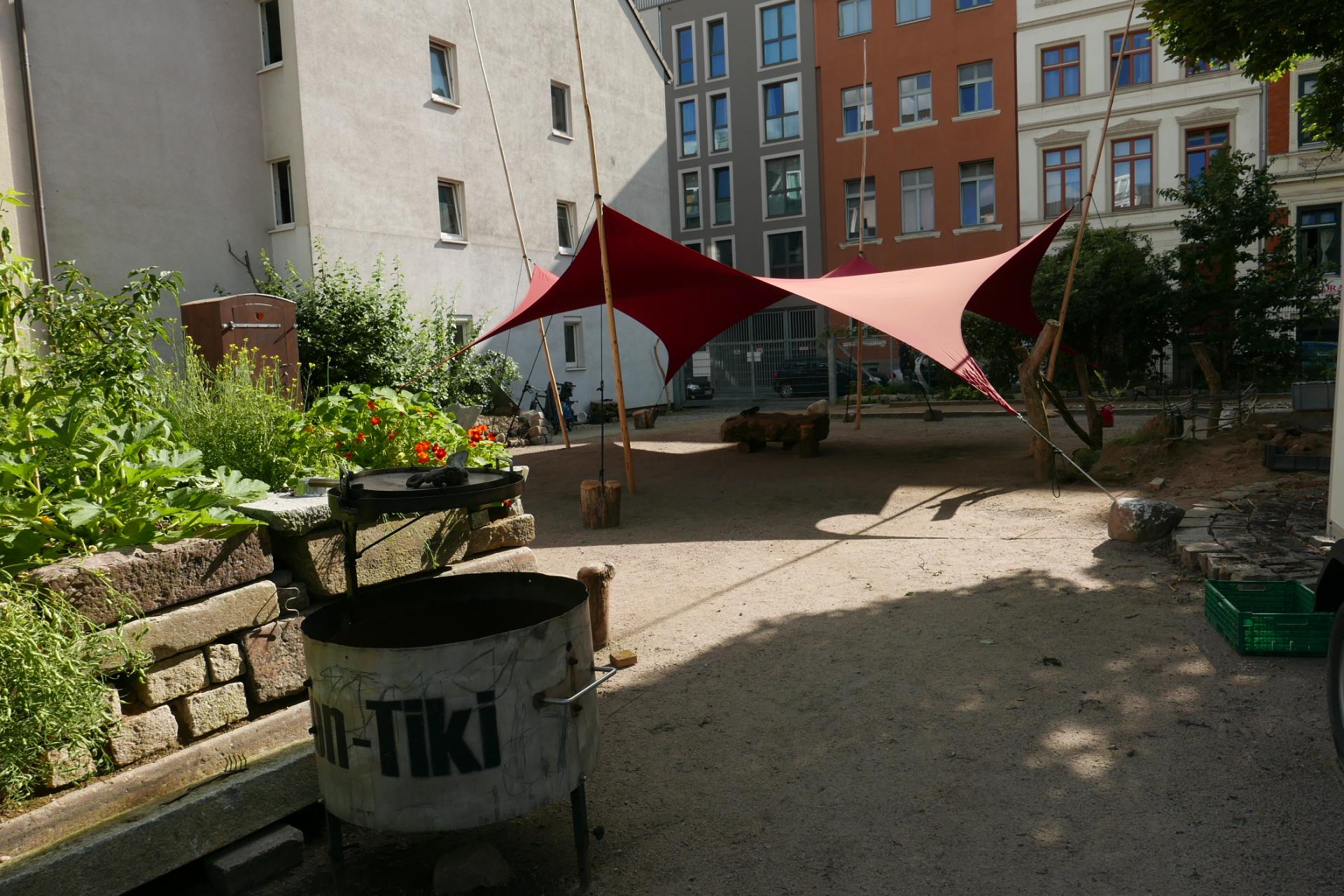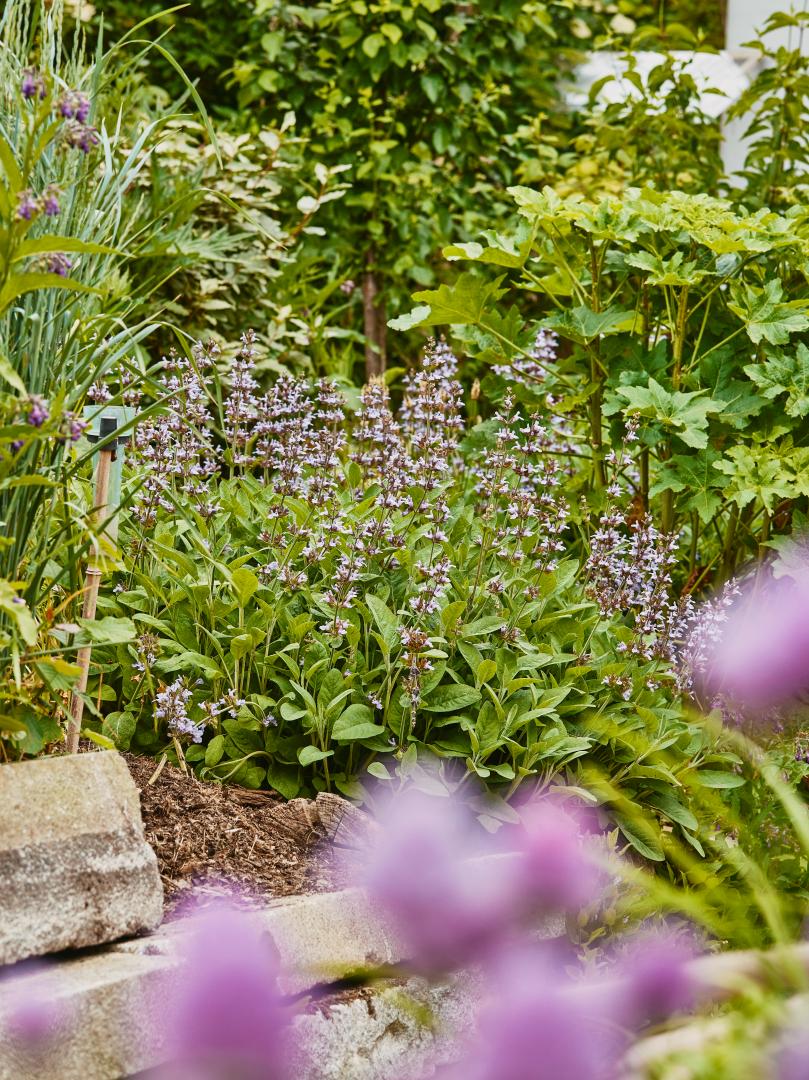Marmorgarten
Basic information
Project Title
Marmorgarten
Full project title
Climate Oasis Marmorgarten
Category
Reconnecting with nature
Project Description
The Marmorgarten is an interreligious and intercultural urban gardening project in the middle of Hamburg St. Georg.
The garden is based on the principles of agroecology, and sustainability.
A dynamic agroforestry has been growing here on 850 square meters since 2020, in which ecological biodiversity and the development of soil fertility are promoted.
The garden is based on the principles of agroecology, and sustainability.
A dynamic agroforestry has been growing here on 850 square meters since 2020, in which ecological biodiversity and the development of soil fertility are promoted.
Geographical Scope
Local
Project Region
Hamburg, Germany
Urban or rural issues
It addresses urban-rural linkages
Physical or other transformations
It refers to a physical transformation of the built environment (hard investment)
EU Programme or fund
No
Description of the project
Summary
Diversity is valued
The Marmorgarten is a collaborative initiative among various institutions led by Rueckenwind e.V., an NGO highly committed to sustainable development. Our project focuses on the creation and the sustainable maintenance of a unique urban community garden in the heart of the city centre of Hamburg. It is a green space that serves as a place for relaxation and learning, fostering a symbiotic relationship between individuals and nature. Our shared value is the respect for the Earth as the foundation of all our existence, advocating for regenerative practices in our daily lives.
The primary target is designed to be inclusive for diverse local residents, fostering a sense of community in the urban landscape. It is imperative that all visitors approach the space with openness and sensitivity. The goal is to counter isolation through meaningful interactions, with resources serving multiple functions for holistic well-being. Before making any changes, a careful examination of existing nuances is crucial. Diversity is highly valued, and feedback is actively sought for continuous self-regulation.
The specific objectives of our vision are centred on cultivating a community and garden that function as an integrated ecosystem. Personal growth is encouraged, promoting a lifestyle that is mutually beneficial for individuals and the planet, prioritising sustainability. The garden's creation revolves around establishing an edible landscape featuring GMO-free and seed-safe plants. Waste reduction is a core principle, achieved through closed cycles and the elimination of commercial fertilisers and pesticides.
At its core, the project addresses the detachment between urban communities and the natural world. It seeks to accomplish this by creating a regenerative, culturally enriched, diverse, and collaborative green space. It actively encourages residents to connect with nature, learn about environmental responsibility, and foster a sense of community ownership.
The Marmorgarten is a collaborative initiative among various institutions led by Rueckenwind e.V., an NGO highly committed to sustainable development. Our project focuses on the creation and the sustainable maintenance of a unique urban community garden in the heart of the city centre of Hamburg. It is a green space that serves as a place for relaxation and learning, fostering a symbiotic relationship between individuals and nature. Our shared value is the respect for the Earth as the foundation of all our existence, advocating for regenerative practices in our daily lives.
The primary target is designed to be inclusive for diverse local residents, fostering a sense of community in the urban landscape. It is imperative that all visitors approach the space with openness and sensitivity. The goal is to counter isolation through meaningful interactions, with resources serving multiple functions for holistic well-being. Before making any changes, a careful examination of existing nuances is crucial. Diversity is highly valued, and feedback is actively sought for continuous self-regulation.
The specific objectives of our vision are centred on cultivating a community and garden that function as an integrated ecosystem. Personal growth is encouraged, promoting a lifestyle that is mutually beneficial for individuals and the planet, prioritising sustainability. The garden's creation revolves around establishing an edible landscape featuring GMO-free and seed-safe plants. Waste reduction is a core principle, achieved through closed cycles and the elimination of commercial fertilisers and pesticides.
At its core, the project addresses the detachment between urban communities and the natural world. It seeks to accomplish this by creating a regenerative, culturally enriched, diverse, and collaborative green space. It actively encourages residents to connect with nature, learn about environmental responsibility, and foster a sense of community ownership.
Key objectives for sustainability
The project was developed on the abandoned site of a marble warehouse in the heart of the city centre. The objective was to establish a space for human interactions, rich in biodiversity, where nature receives what it needs to thrive. Additionally, the project aims to address the climate crisis within a confined area, providing people with an immersive experience in the midst of the metropolis. This offers the opportunity to live and engage with the Sustainable Development Goals (SDGs) right at your doorstep.
The project has successfully achieved its regenerative objectives by creating an agroecology, environmentally conscious green space. It stands out as an exemplary model for other community-driven initiatives, emphasising community engagement, urban sustainability, environmental education, biodiversity support, inclusivity, and social cohesion in metropolitan environments.
In the context of reconnecting with nature, the project can be exemplary for several reasons, including its strong focus on community engagement, its contribution to urban sustainability by transforming urban spaces into green oases, its commitment to environmental education, its promotion of biodiversity in urban settings, and its emphasis on inclusivity and social cohesion in metropolitan environments. Overall, the project not only meets its sustainability goals but also serves as a valuable model for other community-driven projects seeking to promote sustainability, inclusivity, and ecological responsibility in urban areas.
The project has successfully achieved its regenerative objectives by creating an agroecology, environmentally conscious green space. It stands out as an exemplary model for other community-driven initiatives, emphasising community engagement, urban sustainability, environmental education, biodiversity support, inclusivity, and social cohesion in metropolitan environments.
In the context of reconnecting with nature, the project can be exemplary for several reasons, including its strong focus on community engagement, its contribution to urban sustainability by transforming urban spaces into green oases, its commitment to environmental education, its promotion of biodiversity in urban settings, and its emphasis on inclusivity and social cohesion in metropolitan environments. Overall, the project not only meets its sustainability goals but also serves as a valuable model for other community-driven projects seeking to promote sustainability, inclusivity, and ecological responsibility in urban areas.
Key objectives for aesthetics and quality
The project has successfully met its key objectives related to aesthetics, quality of experience, and cultural enrichment. It has transformed a former parking lot into a visually appealing, culturally significant, and emotionally satisfying green space. We work with granite walls to capture the sun heat and integrate social spaces for exchange, observation and being. For the summer time we have thermal inversion rooms with trees, bushes and climbing plants. If it rains, we do have shelter under a 8x8m tent. When we are cold or hungry, we can light a pyrolysis oven to produce biochar to sequester carbon at the same time and thus quickly advance the development of soil fertility by using resources harvested in the city.
We have crafted a multifunctional landscape that nurtures the flourishing of both people and the biome. Our vision includes the development of fully edible, versatile spaces that contribute to the thriving of both human communities and the surrounding environment. We build cultural bridges by incorporating plants native to the countries of origin of the individuals we collaborate with. We place great emphasis on cleanliness, applying a high care approach to the entire ecosystem within our community. The garden's commitment to preserving cultural heritage, promoting emotional well-being, facilitating community and cultural exchange, and integrating artistic expression makes it an exemplary model for other urban projects. It showcases the importance of creating spaces that enrich the lives of people and foster cultural appreciation in urban environments.
While understanding the created space is valuable, the essence lies in experiencing it, grasping with all your senses!
We have crafted a multifunctional landscape that nurtures the flourishing of both people and the biome. Our vision includes the development of fully edible, versatile spaces that contribute to the thriving of both human communities and the surrounding environment. We build cultural bridges by incorporating plants native to the countries of origin of the individuals we collaborate with. We place great emphasis on cleanliness, applying a high care approach to the entire ecosystem within our community. The garden's commitment to preserving cultural heritage, promoting emotional well-being, facilitating community and cultural exchange, and integrating artistic expression makes it an exemplary model for other urban projects. It showcases the importance of creating spaces that enrich the lives of people and foster cultural appreciation in urban environments.
While understanding the created space is valuable, the essence lies in experiencing it, grasping with all your senses!
Key objectives for inclusion
Social plastic
The Marmorgarten has successfully realised its objectives prioritising inclusion through a focus on accessibility affordability, inclusive governing systems, design for all principles, and the promotion of new societal models. As a non-partisan, interreligious, biodiverse space, we openly engage with neighbours, institutions, companies, schools, tourists, and more, welcoming them to experience our place.
The city of Hamburg provides financial support for our project, enabling us to offer free services to neighbours and the general public. We invite everybody to become a part of the garden. With love and care, we ensure the maintenance of the space, fostering a high level of joy for both visitors and participants. We believe in the development of frames that are similar in nature and can be applied to the Marmorgarten.
Furthermore, within this context, Rückenwind e.V. assists delinquent juveniles in fulfilling their court-imposed community service and it provides integrative support for young individuals engaged in work, fostering interactions with the St. Georg community and facilitating contact with nature.
The active involvement of these juveniles has played a significant role in the substantial development of this project. Serving as an exemplary model, the Marmorgarten showcases how urban green spaces can be designed to accommodate diverse populations, ensuring accessibility, affordability, and inclusivity for all community members.
The project's emphasis on participatory governance and sustainability challenges traditional urban design and governance concepts, providing a noteworthy example for other projects to follow.
The Marmorgarten has successfully realised its objectives prioritising inclusion through a focus on accessibility affordability, inclusive governing systems, design for all principles, and the promotion of new societal models. As a non-partisan, interreligious, biodiverse space, we openly engage with neighbours, institutions, companies, schools, tourists, and more, welcoming them to experience our place.
The city of Hamburg provides financial support for our project, enabling us to offer free services to neighbours and the general public. We invite everybody to become a part of the garden. With love and care, we ensure the maintenance of the space, fostering a high level of joy for both visitors and participants. We believe in the development of frames that are similar in nature and can be applied to the Marmorgarten.
Furthermore, within this context, Rückenwind e.V. assists delinquent juveniles in fulfilling their court-imposed community service and it provides integrative support for young individuals engaged in work, fostering interactions with the St. Georg community and facilitating contact with nature.
The active involvement of these juveniles has played a significant role in the substantial development of this project. Serving as an exemplary model, the Marmorgarten showcases how urban green spaces can be designed to accommodate diverse populations, ensuring accessibility, affordability, and inclusivity for all community members.
The project's emphasis on participatory governance and sustainability challenges traditional urban design and governance concepts, providing a noteworthy example for other projects to follow.
Results in relation to category
The Marmorgarten project has achieved notable results, outcomes, and impacts in reconnecting people with Nature. Here are specific benefits for both direct and indirect beneficiaries:
Creation of a Green Oasis: The transformation of a former parking lot into a lush green space provides a tangible result, offering a visually appealing and nature-infused environment offering living space for endangered species like the Rhinoceros beetle (Oryctes nasicornis)
Educational Programs: The project's focus on sustainability and environmental consciousness includes educational programs. Direct beneficiaries, such as community members and visitors, gain knowledge about agroecology, organic gardening, and eco-friendly practices.
Accessible and Inclusive Design: The implementation of accessible pathways and inclusive design elements ensures that individuals with diverse abilities can directly benefit from the garden, promoting a sense of inclusivity.
Impacts:
Increased Environmental Awareness: Direct beneficiaries, through participation in educational programs, gain an increased awareness of environmental issues and the importance of sustainable practices.
Community Cohesion: The communal activities and shared responsibilities within the garden foster a sense of community cohesion among direct beneficiaries, enhancing social bonds.
Positive Mental Health Impact: Access to a green and serene environment positively impacts the mental health and well-being of direct beneficiaries, offering a respite from urban stressors.
Promotion of Sustainable Practices: The adoption of agroecology and organic gardening practices in the garden inspires direct beneficiaries to incorporate sustainable practices into their own lives, contributing to a broader cultural shift. With these scaled models, we show the possibilities available to agriculture on larger areas and present them to the public
Creation of a Green Oasis: The transformation of a former parking lot into a lush green space provides a tangible result, offering a visually appealing and nature-infused environment offering living space for endangered species like the Rhinoceros beetle (Oryctes nasicornis)
Educational Programs: The project's focus on sustainability and environmental consciousness includes educational programs. Direct beneficiaries, such as community members and visitors, gain knowledge about agroecology, organic gardening, and eco-friendly practices.
Accessible and Inclusive Design: The implementation of accessible pathways and inclusive design elements ensures that individuals with diverse abilities can directly benefit from the garden, promoting a sense of inclusivity.
Impacts:
Increased Environmental Awareness: Direct beneficiaries, through participation in educational programs, gain an increased awareness of environmental issues and the importance of sustainable practices.
Community Cohesion: The communal activities and shared responsibilities within the garden foster a sense of community cohesion among direct beneficiaries, enhancing social bonds.
Positive Mental Health Impact: Access to a green and serene environment positively impacts the mental health and well-being of direct beneficiaries, offering a respite from urban stressors.
Promotion of Sustainable Practices: The adoption of agroecology and organic gardening practices in the garden inspires direct beneficiaries to incorporate sustainable practices into their own lives, contributing to a broader cultural shift. With these scaled models, we show the possibilities available to agriculture on larger areas and present them to the public
How Citizens benefit
Citizens and civil society have played a significant role in shaping the design and development of the project . They actively participated in the garden's design, providing insights into its layout, plant selection, and design features. This participatory approach ensured that the project aligned with the community's desires and preferences, resulting in a space that truly meets their needs.
Community engagement and volunteerism have been essential elements of the project. Citizens and civil society members generously donated their time and labour for tasks such as planting, weeding, and general maintenance. This not only reduced project costs but also fostered a sense of ownership and community pride. It has created a space where people feel deeply connected and responsible for its well-being.
The project's educational objectives have been realised through the active participation of citizens. They have engaged in educational programs and activities related to sustainability, agroecology, and environmental consciousness. This involvement has contributed to increased awareness and knowledge among community members, aligning with the project's educational goals.
The environmental regeneration of the project has been significantly enhanced through the involvement of citizens. They have become stewards of the garden's environmental practices, actively participating in waste reduction, composting, and the practice of organic gardening. This involvement contributes to the project's green and eco-friendly goals and promotes sustainable living practices.
Community engagement and volunteerism have been essential elements of the project. Citizens and civil society members generously donated their time and labour for tasks such as planting, weeding, and general maintenance. This not only reduced project costs but also fostered a sense of ownership and community pride. It has created a space where people feel deeply connected and responsible for its well-being.
The project's educational objectives have been realised through the active participation of citizens. They have engaged in educational programs and activities related to sustainability, agroecology, and environmental consciousness. This involvement has contributed to increased awareness and knowledge among community members, aligning with the project's educational goals.
The environmental regeneration of the project has been significantly enhanced through the involvement of citizens. They have become stewards of the garden's environmental practices, actively participating in waste reduction, composting, and the practice of organic gardening. This involvement contributes to the project's green and eco-friendly goals and promotes sustainable living practices.
Physical or other transformations
It refers to a physical transformation of the built environment (hard investment)
Innovative character
The Marmorgarten project demonstrates significant innovation compared to mainstream actions in the field of community-driven urban development and green space creation. Its innovative character is evident through several key aspects:
● A strong focus on permaculture and agroecology, promoting sustainability and self-sustaining agricultural practices.
● A commitment to inclusivity and accessibility for people of all backgrounds and abilities.
● An emphasis on cultural enrichment, with community events and artistic performances.
● Collaborative governance, engaging citizens in decision-making for a more democratic approach.
● A role as an educational resource, offering programs related to sustainability and environmental consciousness.
● Interdisciplinary collaboration among experts from various fields for a more holistic approach.
● Sustainability, minimising waste and avoiding commercial fertilisers and pesticides.
● Preservation of historical and cultural significance through the garden's name.
● This innovative approach transcends traditional models of community gardens, providing a comprehensive and forward-thinking solution to urban green spaces and community-driven initiatives
● A strong focus on permaculture and agroecology, promoting sustainability and self-sustaining agricultural practices.
● A commitment to inclusivity and accessibility for people of all backgrounds and abilities.
● An emphasis on cultural enrichment, with community events and artistic performances.
● Collaborative governance, engaging citizens in decision-making for a more democratic approach.
● A role as an educational resource, offering programs related to sustainability and environmental consciousness.
● Interdisciplinary collaboration among experts from various fields for a more holistic approach.
● Sustainability, minimising waste and avoiding commercial fertilisers and pesticides.
● Preservation of historical and cultural significance through the garden's name.
● This innovative approach transcends traditional models of community gardens, providing a comprehensive and forward-thinking solution to urban green spaces and community-driven initiatives
Disciplines/knowledge reflected
The Marmorgarten project reflects a holistic and interdisciplinary approach with the involvement of experts from diverse fields, including landscape architecture, environmental science, engineering horticulture, fruticulture, agroforestry, social sciences, architecture, education, arts, and government. These experts collaborate to create a well-rounded project that addresses aesthetic, ecological, social, and cultural aspects. The added value of this interdisciplinary process includes innovation, best practices, educational and cultural enrichment, sustainability, and meaningful community engagement. This comprehensive approach ensures the project's success and its role as an exemplar of inclusive, sustainable, and culturally enriched urban initiatives
Methodology used
The methodology employed in the Marmorgarten project is characterised by a comprehensive and community-driven process that incorporates various key principles. Here is an overview of the methodology:
Participatory Design: The project's methodology begins with participatory design, involving local community members in decision-making from the project's inception. Their input guides the garden's layout, plant selection, and design features, ensuring that it reflects their needs and preferences.
Sustainability and Agroecology: The project integrates principles of sustainability and agroecology, emphasizing eco-friendly and closed-loop resource management. This includes organic gardening, minimizing waste, and avoiding commercial fertilisers and pesticides.
Educational Resource: The garden serves as an educational resource, with experts in education and sustainability designing and delivering programs related to agroecology, sustainability, and environmental consciousness.
Accessibility and Inclusivity: The project's approach prioritises accessibility and inclusivity, going beyond basic accessibility features to consider the diverse needs of community members. This ensures that the garden is welcoming to people of all backgrounds and abilities.
Community Engagement and Volunteerism: An essential part of the approach is fostering community engagement and volunteerism. Local citizens actively participate in gardening, maintenance, and community-building activities, fostering a strong sense of ownership and community pride
Historical and Cultural Preservation: The project, named to acknowledge the historical background of the site, aims to revive it as a food production space reminiscent of its 18th-century use, contributing to historical and cultural preservation. The methodology is characterized by a comprehensive and community-oriented approach, emphasizing the project's goal to be a vibrant, sustainable, inclusive, and culturally enriched asset for the community
Participatory Design: The project's methodology begins with participatory design, involving local community members in decision-making from the project's inception. Their input guides the garden's layout, plant selection, and design features, ensuring that it reflects their needs and preferences.
Sustainability and Agroecology: The project integrates principles of sustainability and agroecology, emphasizing eco-friendly and closed-loop resource management. This includes organic gardening, minimizing waste, and avoiding commercial fertilisers and pesticides.
Educational Resource: The garden serves as an educational resource, with experts in education and sustainability designing and delivering programs related to agroecology, sustainability, and environmental consciousness.
Accessibility and Inclusivity: The project's approach prioritises accessibility and inclusivity, going beyond basic accessibility features to consider the diverse needs of community members. This ensures that the garden is welcoming to people of all backgrounds and abilities.
Community Engagement and Volunteerism: An essential part of the approach is fostering community engagement and volunteerism. Local citizens actively participate in gardening, maintenance, and community-building activities, fostering a strong sense of ownership and community pride
Historical and Cultural Preservation: The project, named to acknowledge the historical background of the site, aims to revive it as a food production space reminiscent of its 18th-century use, contributing to historical and cultural preservation. The methodology is characterized by a comprehensive and community-oriented approach, emphasizing the project's goal to be a vibrant, sustainable, inclusive, and culturally enriched asset for the community
How stakeholders are engaged
Stakeholder engagement at multiple levels plays a vital role in the success of the Marmorgarten project. Local stakeholders, including citizens, organisations, politicians, businesses and the local government, bring local insights and a sense of community ownership to the project.
Our NGO, Rueckenwind e.V., holds a NUN (North German and Sustainable ESD) certification, as does the Marmorgarten, and is included in the Hamburg 2030 ESD Master Plan. The project receives financial support from the city of Hamburg and the Hamburg Climate Protection Foundation. Additional support comes from Treesolutions, Vattenfall, Ristorante La Famiglia and many other volunteers who have generously provided resources.
Rueckenwind is actively involved in supporting 11 other projects in the Hamburg metropolitan region. Drawing from our 13 years of experience, we have found that social projects benefit significantly from the assistance of our NGO. We help compensate for the inevitable ups and downs in their development, ensuring their sustainability in the short, medium and long term.
Engagement at the European level, as part of the New European Bauhaus initiative, offers the prospect of recognition, funding, and alignment with broader sustainability goals. The collective involvement of these stakeholders brings distinctive value to the project, positioning it as an exemplary model for a community-driven, inclusive, and sustainable urban initiative. This alignment resonates with regional, national, and European objectives and values.
Our NGO, Rueckenwind e.V., holds a NUN (North German and Sustainable ESD) certification, as does the Marmorgarten, and is included in the Hamburg 2030 ESD Master Plan. The project receives financial support from the city of Hamburg and the Hamburg Climate Protection Foundation. Additional support comes from Treesolutions, Vattenfall, Ristorante La Famiglia and many other volunteers who have generously provided resources.
Rueckenwind is actively involved in supporting 11 other projects in the Hamburg metropolitan region. Drawing from our 13 years of experience, we have found that social projects benefit significantly from the assistance of our NGO. We help compensate for the inevitable ups and downs in their development, ensuring their sustainability in the short, medium and long term.
Engagement at the European level, as part of the New European Bauhaus initiative, offers the prospect of recognition, funding, and alignment with broader sustainability goals. The collective involvement of these stakeholders brings distinctive value to the project, positioning it as an exemplary model for a community-driven, inclusive, and sustainable urban initiative. This alignment resonates with regional, national, and European objectives and values.
Global challenges
The Marmorgarten project addresses several global challenges by offering local solutions. Here are some of the key global challenges that the project effectively tackles at the local level:
Climate Change and Sustainability: The project promotes sustainability and permaculture, minimising waste, avoiding commercial fertilisers and pesticides, and emphasising eco-friendly practices. By reducing its environmental footprint, the project contributes to mitigating climate change and promoting environmental sustainability.
Biodiversity Loss: Through its agroecology focus and diverse plantings, the garden supports biodiversity by creating a habitat for various plant and animal species. This local effort contributes to the broader global goal of preserving biodiversity.
Inclusivity and Social Equity: The project prioritises inclusivity, welcoming people of all backgrounds and abilities. This addresses broader global challenges related to social equity and inclusivity, promoting a model for diverse and inclusive community spaces.
Education for Sustainable Development: By offering educational programs on sustainability and environmental consciousness, the project contributes to the global goal of education for regenerative development. It empowers individuals with knowledge and skills to address environmental challenges.
Community Resilience: The project fosters community engagement and volunteerism, building community resilience. This local resilience can serve as a model for building resilience in the face of global challenges, such as natural disasters or economic disruptions.
Community Well-Being: The project enhances community well-being by providing a green and peaceful space for relaxation and interaction.
Sustainable Agriculture: By focusing on agroecology and organic gardening, the project supports sustainable agriculture practices. Sustainable agriculture is essential for global food security and reducing the environmental impact of food production.
Climate Change and Sustainability: The project promotes sustainability and permaculture, minimising waste, avoiding commercial fertilisers and pesticides, and emphasising eco-friendly practices. By reducing its environmental footprint, the project contributes to mitigating climate change and promoting environmental sustainability.
Biodiversity Loss: Through its agroecology focus and diverse plantings, the garden supports biodiversity by creating a habitat for various plant and animal species. This local effort contributes to the broader global goal of preserving biodiversity.
Inclusivity and Social Equity: The project prioritises inclusivity, welcoming people of all backgrounds and abilities. This addresses broader global challenges related to social equity and inclusivity, promoting a model for diverse and inclusive community spaces.
Education for Sustainable Development: By offering educational programs on sustainability and environmental consciousness, the project contributes to the global goal of education for regenerative development. It empowers individuals with knowledge and skills to address environmental challenges.
Community Resilience: The project fosters community engagement and volunteerism, building community resilience. This local resilience can serve as a model for building resilience in the face of global challenges, such as natural disasters or economic disruptions.
Community Well-Being: The project enhances community well-being by providing a green and peaceful space for relaxation and interaction.
Sustainable Agriculture: By focusing on agroecology and organic gardening, the project supports sustainable agriculture practices. Sustainable agriculture is essential for global food security and reducing the environmental impact of food production.
Learning transferred to other parties
The Marmorgarten project offers replicable elements and valuable lessons for creating inclusive, sustainable, and culturally enriched community spaces. These include participatory design, interdisciplinary collaboration, agroecology and sustainability practices, educational resources, cultural enrichment, accessibility, community engagement, historical preservation, collaboration with government bodies, environmental sustainability, and fostering innovation and best practices. These elements can inspire similar initiatives in different places and contexts
In addition to its local impact, the Marmorgarten project has played a crucial role in transferring knowledge and best practices to projects in the Canary Islands and the south of Portugal. This expansion beyond its initial location demonstrates the project's influence and potential to inspire similar initiatives in different geographical contexts.
Moreover, the project looks forward to implementing its successful model on a larger scale, particularly in farming environments. This forward-looking approach indicates the project's ambition to contribute to sustainable practices and community enrichment on a broader scale, extending its positive influence to various regions and sectors.
The Marmorgarten represents a valuable tool to respond to the climate crisis with resilience. For this purpose, we offer an ongoing nature workspace in which mankind can meet the paradigm shift in a solution driven approach. Therefore we have created a scaled agroforestry system, a Market Garden as well as several wickingbeds
In addition to its local impact, the Marmorgarten project has played a crucial role in transferring knowledge and best practices to projects in the Canary Islands and the south of Portugal. This expansion beyond its initial location demonstrates the project's influence and potential to inspire similar initiatives in different geographical contexts.
Moreover, the project looks forward to implementing its successful model on a larger scale, particularly in farming environments. This forward-looking approach indicates the project's ambition to contribute to sustainable practices and community enrichment on a broader scale, extending its positive influence to various regions and sectors.
The Marmorgarten represents a valuable tool to respond to the climate crisis with resilience. For this purpose, we offer an ongoing nature workspace in which mankind can meet the paradigm shift in a solution driven approach. Therefore we have created a scaled agroforestry system, a Market Garden as well as several wickingbeds
Keywords
Biodiversity
Resilience
Regenerative
Inclusivity
Innovation

